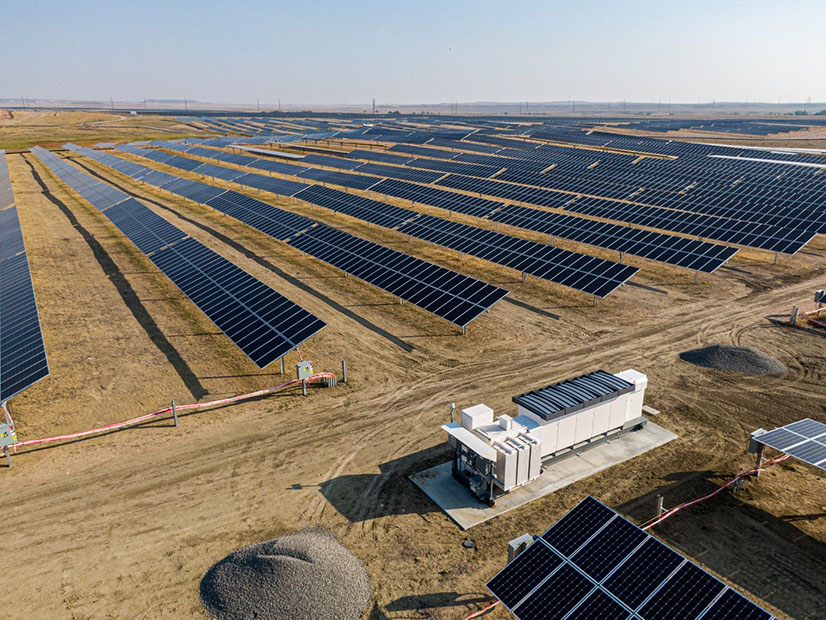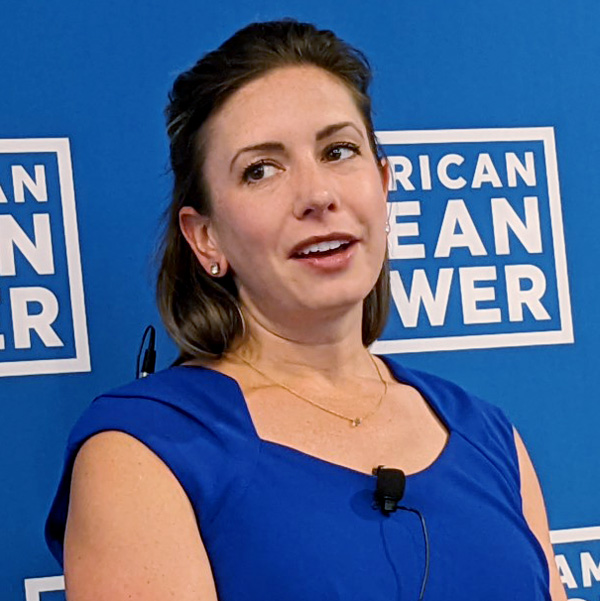
States Want to Deploy More Storage, but Developers Call for Better Planning Tools, Valuation
WASHINGTON — Michigan’s new roadmap for energy storage has set ambitious targets for the state: 1,000 MW online by 2025, 2,500 MW by 2030 and 4,000 MW by 2040.
In Colorado, the state is targeting an 80% reduction in greenhouse gas emissions by 2030, which could trigger “investments of close to $12 billion in wind, solar, storage, peaking capacity and transmission,” according to Eric Blank, chair of the state’s Public Utilities Commission.
But for regulators like Blank and storage developers speaking at the American Clean Power Association (ACP)’s Energy Storage Policy Forum on Wednesday, meeting such targets presents a range of problems, from declining capacity values of projects pairing solar and storage to the challenges of financing storage in restructured markets.
 Michael DeSocio, NYISO, speaks as (from left) Dave Maggio, ERCOT; Andrew Levitt, PJM; and Jason Burwen, American Clean Power Association, listen. MISO’s Laura Rauch participated via video. | © RTO Insider LLC
Michael DeSocio, NYISO, speaks as (from left) Dave Maggio, ERCOT; Andrew Levitt, PJM; and Jason Burwen, American Clean Power Association, listen. MISO’s Laura Rauch participated via video. | © RTO Insider LLC
“Solar just falls off more quickly than the peak demand,” said Blank, who appeared at the forum via a video hookup. “So, we’re finding reduced capacity value for both solar-plus-storage, and roughly every 5 to 10% increase in penetration reduces the capacity value by 20% … and we’re now seeing values at 70% coming down more towards 50%.”
Those figures raise a critical question, Blank said. “Is there a real limitation to how much [solar and storage] we can do?”
For Julian Boggs, manager for regulatory and policy affairs at Key Capture Energy, a New York-based storage developer, lower capacity values mean projects may not pencil out, especially in states with restructured markets.
Key Capture has been successful with projects in vertically integrated markets, Boggs said, because it has been able to “internalize a lot of the system optimization benefits in the [integrated resource plan] modeling, in looking out [at] your system over 20 years. … But it has been a huge challenge in restructured states. How do we finance given the capacity values and the energy values and whatever you can skim off energy and ancillary services markets?”
 Ted Wiley, Form Energy | © RTO Insider LLC
Ted Wiley, Form Energy | © RTO Insider LLC
States may have aggressive climate goals and want to “deploy, deploy, deploy,” he said, “but how do you finance projects? How do you get long-term support? … We need to start thinking differently about how we use state support to fill in the missing money effectively in these restructured markets where the wholesale markets aren’t delivering the revenue piece.”
Similarly, Ted Wiley, president and chief operating officer of storage developer Form Energy, said utilities and regulators must also think differently about their long-term planning processes. With backing from Bill Gates’ Breakthrough Energy Ventures, Form is developing a long-duration technology that, Wiley said, could offer up to 100 hours of storage to provide resilience and reliability to the grid.
“There’s a whole host of other technologies that are being developed that are the next wave of storage. We need to be included in the planning process before we reach maturity in order to be a factor,” he said. “That planning has to happen now; [it] has to be a new kind of planning.”
 Michigan PSC Commissioner Katherine Peretick | © RTO Insider LLC
Michigan PSC Commissioner Katherine Peretick | © RTO Insider LLC
Michigan Public Service Commissioner Katherine Peretick said that whatever the technology, valuation will be key to forward planning.
“If you have the right value for the technology that’s in front of you, you’ll pay for the services you want,” she said. Utilities need to “make sure that they are properly valuing the storage asset, both for the value it can provide to the grid, as well as how much it costs to operate.”
“Both sides of that coin are really necessary to make sure than when you plug that into the IRP model, it’s coming out with the right results,” she said. Developers will need to work closely with utilities to get the input numbers right, she said.
Not Ready for 100-hour Storage
While rising prices and supply chain and interconnection delays are expected to slow growth in the U.S. energy storage market this year, the sector scored a record first quarter, according to the most recent Energy Storage Market Monitor from ACP and industry analyst Wood Mackenzie. Total installations — including residential, nonresidential and grid-scale storage — totaled 955 MW/2,875 MWh, about a fourfold increase from Q1 2021, the report said.
That growth would have been even higher, but 1.2 GW of grid-scale projects that were originally scheduled to come online in the first quarter have been delayed, although about three-quarters are still slated to come online this year, the report said.
Grid-scale solar-plus-storage projects took a hit from the recent procurement bottleneck caused by the U.S. Commerce Department investigation of solar imports from Cambodia, Laos, Thailand and Vietnam. The impacts to project pipelines could continue into 2023, despite President Biden’s recent action to waive duties on solar imports from those countries for two years, the report said. (See Biden Waives Tariffs on Key Solar Imports for 2 Years.)
What the figures also show is that the market thus far is focused on shorter-duration uses of storage — an average of three hours — provided by lithium-ion batteries.
From a planning perspective, regulators and utilities are not ready for 100-hour storage, Colorado PUC Chair Blank said. In Colorado, “it’s literally outside our [electric load calculation] studies, which end at 16 hours.”
But, he said, Colorado does have a new program that will pay above-market rates for innovative technologies not yet at scale. But, he cautioned, in such cases, “the technology risks have to be on the vendor or the technology provider, and not on the customer or the utility. So, the form of the transaction shouldn’t be rate-based; it needs to be off-take.”
For Wiley, a new approach to planning should begin with asking, “What is the grid we are trying to build out? What kind of planning tools do we need for that?”
He also believes that the “levelized cost of electricity is no longer the metric we should be looking at. When evaluating storage, we should be looking at a value created at the portfolio level by an asset that allows and optimizes the portfolio, optimizes the generation, transmission and distribution [systems] across all of the asset classes.”
Clean Capacity
Key Capture’s Boggs said states may need to develop a “clean capacity” renewable energy credit to help them meet aggressive storage targets, like Michigan’s or Colorado’s.
Massachusetts’ clean peak standard — incentivizing technologies that can provide clean energy during times of peak demand — is “a halfway evolution … really still based on the REC framework,” he said. But the clean peak approach is still “incentivizing storage only to discharge during certain hours versus doing whatever is most valuable for the grid,” he said.
Blank sees RTO wholesale markets going to a “direct procurement-type approach” for energy storage. “These markets just fundamentally overpay for energy and underpay for capacity,” he said, so relying on a REC-type approach would be “a heavy lift.”
But both Boggs and Wiley argued that storage should be classified as a clean capacity resource.
“It’s certainly not a great idea from a policy perspective to be buying megawatt-hours from storage,” Boggs said. In using storage as capacity, “you’re buying the value of having a clean, flexible resource that is able to respond and optimize the system in any given number of circumstances and participate, whether it’s an ancillary services market; an energy market; whatever the market is [that] is most needed for you to participate in.”
The target for storage, said Wiley, “is to be replacing fossil-based assets that are providing capacity. So, in my mind, that leads me to a 24/7 type construct … a 24/7 carbon-free, clean capacity asset that can replace a fossil asset. That’s what we’re going for.”


